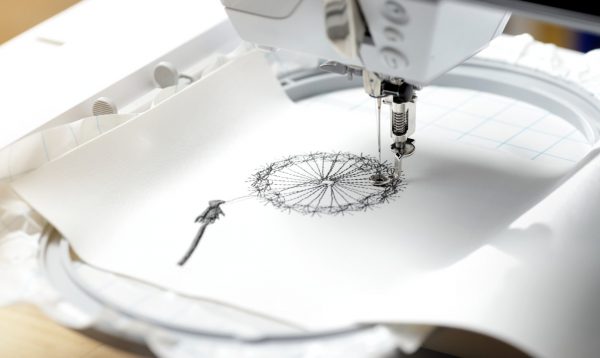So, our tale about the road to the successful home-run embroidery business came to a point where we need to address the issue of finding a niche for your setup. Where to look for potential niches? How to make it done? What will work for your business in particular? Is it possible to start at one niche and then transcend to another? If yes, how do you do it?
All these questions, as well as many others, relative to the topic, will be answered in the present article. What’s more, the article “How to find your niche in embroidery business?” gives you a step-by-step plan, of how to actually proceed with the endeavor.
To make the reading easier, more relatable and helpful, we’ll provide the plan with examples, tips and little marketing tricks. Are you interested in such kind of information? Well, then, let’s get down to reading!
How to fine your niche in embroidery business: a step-by-step plan
- Think of the type of the product or service you can offer.
- Think if your product will be wanted in the region, area (amidst your potential clients in general)
- Assess your competition.
- Think of what can make you stand out amidst the competition and make the according adjustments.
If this plan sounds easy to you, then you can start working on putting it into life without further ado. If, however, you need a bit more explanation with it, read on. Further we’ll be discussing each of the steps in a detailed form.
1 – Think of the type of the product or service you can offer
This step starts with few questions that you need to ask yourself as a business owner, a crafter and an individual too. What interests you in embroidery most of all? Is it making customized with stitched embellishments apparel? Maybe you love putting together personalized gift-sets for baby-showers? All of these questions should be answered by you, as a crafter and individual. Why? Because it’d be easier to establish a niche where you’ll be selling things that you already love creating.
After that, turn to your business owner part. What equipment (embroidery machine, sewing machine etc.) do you have? Does your equipment have the needed power capacity? If this your new business is only a side-business to your a full-time job, will you have time to work on your orders?
Example: You have a single needle domestic embroidery machine and you have a fulltime job, not related to embroidery. This means that with the time and productivity level, available to you at the present moment, you can manage individual orders such as embroidery of apparel, household textiles etc. Large corporate orders (like making patches for uniforms of a security business), at present time, will be a bit more difficult for you to deliver. Leave “the big fish” till later, when your business can handle its size. If you don’t, you and your equipment too will be put under too much amount of stress. It may lead to discouragement in what you love to do and loss of investment too. But, if you play your cards right at the beginning, you’ll certainly grow into managing large orders. For now, make the most of what you have.
2 – Think if your product will be wanted in your region, area (amidst your potential clients in general)
Simply put, you know what you can offer, now look for the demand for your offer.
Example 1: Look for new businesses opening in around your area: hair and beauty salons, small cafés, family-run restaurants etc. All these shops are small businesses which you can cater for. Towels with salon’s logos, table linens with the names of the restaurants – these can be your potential orders. Make some samples, arrange meetings with the owners and offer them your services.
How to find your niche in embroidery business
Example 2: Baby items – huge area with multiple niches to take, even with a single needle embroidery machine and only few working hours per day. Look around in malls, shopping centers, baby shops etc. to learn what types of products are in demand. Get few of the most popular items and customize them with your embroidery. Make people know about it through social media or other means available to you. Friends and family can help you spread the word. See if there’s demand for your personalized baby items and act accordingly.
All the above examples target groups which can afford a little “reasonable” luxury of having not just necessities, but, what we call, “the frills”. These groups create demand for embroidery customization, personalization etc. Embroidery, however, can do more than just that and still offer a quite profitable niche.
Example 3: Your area can’t boast of any development: shops are closing; people are getting laid off etc. In this context it’s highly doubtful that anyone will be interested in buying embroidery right? Wrong! Just by posing yourself not as “a provider of customized items”, but as “a clothes repair shop” you’ll be able to have a lot of potential clients.
All the mentioned cases have to do with major marketing trends, which can influence the choice of your embroidery niche. Besides them, there’re also smaller ones that can be just as well worthy of your consideration when establishing a niche. One of such “minor” details is the type of designs that you use.
Example 4: There’s a point of view, which some embroidery masters follow, that different people like different types of embroidery. Some like delicate and light stitching, others prefer bold logos etc. There’re even quite successful businesses which build their product line on such design types differentiation. They specialize on customizing items with bold, vivid writings, monograms and logos.
3 – Assess your completion
Now that the issues of offer and demand are settled, it’s time to learn about the competition. Knowing your competition will give you advantage of managing the your offer (niche) accordingly. So how do you learn about your competition? Here’re some tips, that you can make use of:
~ Checking Yellow Pages is the first and the most obvious step you can take. You shouldn’t however count only on this source, as it might not include some smaller home-run businesses. And this type of businesses is what makes up a pretty hefty part of competition in any embroidery niche.
~ There’re certain online tools, which can provide information (lists) on embroidery businesses in your area. To find such information you can look for specialized websites, forums or simply google “list of nearby embroidery businesses”. Otherwise various internet social media platforms provide valuable info on what private embroidery businesses are located in your area. Look for accounts with embroidery hashtags (#) and photos.
~ Checking those lists, however, won’t be enough. You need to learn to scale those businesses to find ones that come into the same category with you. It’d be unwise to try to compete with larger setups, oriented on mass embroidery production. A nearby sewing-shop, which sews and embroiders clothes, on the other hand, is a potent competitor of a home embroidery business.
~ Besides printed and online ads and lists, there’s also a “word-to-word” kind of inquires, which can help you learn about your competition. Check with local stores, selling embroidery supplies, textiles, fabrics, clothes and other merchandise, which can potentially be used for embroidery. These locales are great for promotion of embroidery services and product. So some of such businesses might leave there their coordinates, cards or even samples.
~ Attend events, where you think there’ll be present other embroidery businesses. Such happenings include: craft events, presentations of various embroidery related brands (equipment, supplies, software etc), yard sales and even hobby clubs evenings. Think of it like this: if you’re interested in representing yourself there, others might be interested too.
4 – Think of what can make you stand out amidst the competition
So, you have a product and you know that other might have similar product too. What can make your embroidery business stand out amidst others? The answer is – several things: prices*, quality, ways of payment, further individualization of orders, packaging, delivery time and ways, etc.
Example: Your local embroidery businesses specialize on embroidery services only. They can embroider, say, various baby items, clothes and linens and that’s it. To stand above the competition, you can offer not only embroidery services but also assembly and packaging ones. Unique, impressive and affordable embroidered gift-sets creation is a niche that your business can thrive in.
*Prices. This item is a really tricky one to consider when trying beating the competition. You never want to undersell yourself because that won’t help your development. You’ll be stuck in the “cheap margin” and your customers will be reluctant to pay more even if costs of the supplies come up. What you can do with the price, is to provide various types of discounts based on the amount of ordered items. Another way to “adjust prices” is to provide special prices for loyal customers. Say, each third or fourth order can come at a lower than usual price.
So, the 4 major steps, leading to finding or establishing a niche for your home embroidery business, are announced. All you need to do now is to follow them and prosper, right? Well, almost… There’re also some points to take into account when following the plan. We gathered some of such points in the form of the following tip list:
TIP #1: Specialize. At the beginning, when you’re only establishing your home embroidery business, don’t squander your time, effort and money trying to embrace all of the possible niches. You need to stand out, to make yourself known. The easiest and quickest way to achieve it is to specialize on a particular service or product.
Example: Start as designer of unique, fashionable accent pillows, decorated with embroidery. After your clients learn and love your “brand”, they might ask for interior accessories of other kinds. You can expand your narrow embroidered pillow niche to a wider interior decoration one.
TIP # 2: Use all the available sources when researching possible niches. Of course you can always consult with a business adviser or a marketing professional. But, if you’re only considering starting an embroidery business, make your own research too. We’ve already mentioned some of the online and offline tools, which can help you with researching your competition. Besides them, there’re also other tools for managing niche establishing needs.
Example 1: Various search engines (like Google or Yahoo) and media platforms (like Pinterest, Instagram etc.) provide “Trend report” feature. This feature can give valuable assessments of popular things, which can be turned into niches. Pinterest base such assessments on the amount of pins, each trend gets. Instagram uses other evaluation “currency”. Get such tools work for you and you’ll have a more rounded market picture.
Example 2: When making your research online, you see lot of advertising pop-ups pestering your working screen. Don’t discard information they show, as it can be a source of your niche inspiration. Take another good look at what they’re advertising, as, they’re based on your own “cookies preferences”. This means that they show you what areas might interest you or relate to your own business. And thus, using them as tool for your developmental strategy, you can expand your niche, your business and your profit too! It’s a little marketing trick, which you can take advantage of, if you know how to!
Example 3: There’s also such thing as embroidery business coaching. A lot of embroidery entrepreneurs made teaching about how to find a niche in embroidery business part of their own business “niche”. Some of them provide mentoring programs; others publish books on the topic. If you feel that you need such kind of consult by all means use it. You’re starting a business and you should be sure in each of your business-related steps.
TIP # 3: Expand your niche as your business grows. In the first TIP we stressed that at the beginning it can be risky to work in several embroidery areas. As your business grows, however, you can make it happen. Here are some means, which help you expand your niche:
- Getting new equipment: more productive embroidery machines, sewing machines, heat presses etc. Be very careful, when investing in new equipment. You don’t want to buy expensive machinery and then let it sit unused.
- Learning additional decorative methods: rhinestones feature can be a really nice addition to a home-based embroidery shop. We’ll be discussing the topic in detail in the upcoming article “Home-run embroidery business: extras that will add to your success”.
- Cooperating with other embroiderer might bring you larger orders, which can be counted in the niche development.
Well, that was some amount of information to take in, right? We get it, don’t worry, it won’t be long till you’ll be through. Just before you go, however, we’d like to sum all of it up in few lines, just to make it easier for you digest. So here’s what you need to do to find a niche for your home embroidery business:
- You’ll need to concentrate on a particular thing, which you’re best at.
- Determine if this thing will sell in your region or online (if you plan on working online too).
- Consider your competition but don’t get intimidated by it. Remember, with the right ideas, management and tools you can be as successful as they are.
- When we say “right ideas and tools”, we mean all the available at the time recourses, used with the right amount of common sense.
In summary, finding your niche in the embroidery business is a blend of personal passion, market research, and strategic planning. It's about discovering a unique intersection where your skills and interests meet the needs and desires of a specific target market. Whether you're drawn to bespoke fashion, personalized home decor, or niche-specific items like sports gear or pet accessories, your niche should reflect both your strengths and the gaps in the current market. Remember, the most successful niches often stem from a deep understanding of your customer's needs and a clear, authentic brand identity. By staying adaptable, continuously learning, and engaging with your community, you can refine your niche over time, ensuring long-term success and satisfaction in your embroidery business. Embrace this journey as an opportunity to express your creativity and connect with others through your art, making each stitch a step towards building a unique and thriving business that truly stands out in the world of embroidery.
You may also like
Home embroidery business: what to charge

Author: Ludmila Konovalova
My name is Lyudmila Konovalova, and I lead Royal Present Embroidery. Embroidery for me is more than a profession; it is a legacy of my Ukrainian and Bulgarian heritage, where every woman in my family was a virtuoso in cross-stitch and smooth stitching. This art, passed down through generations, is part of my soul and a symbol of national pride.
Date: 27.12.2023







 Get Sign-In Link
Get Sign-In Link Login with Google
Login with Google Login with Facebook
Login with Facebook Login with Amazon
Login with Amazon Login with Paypal
Login with Paypal